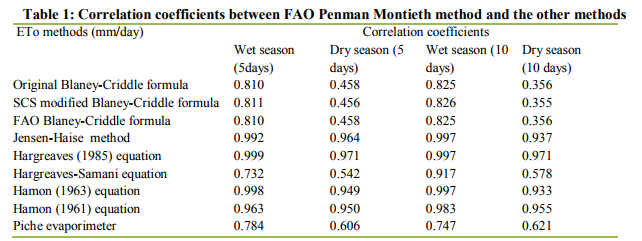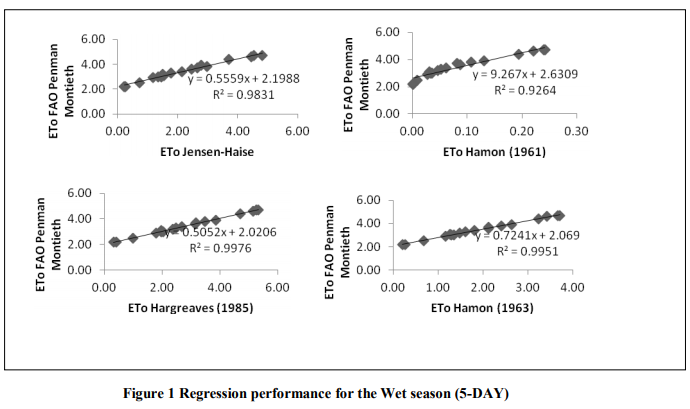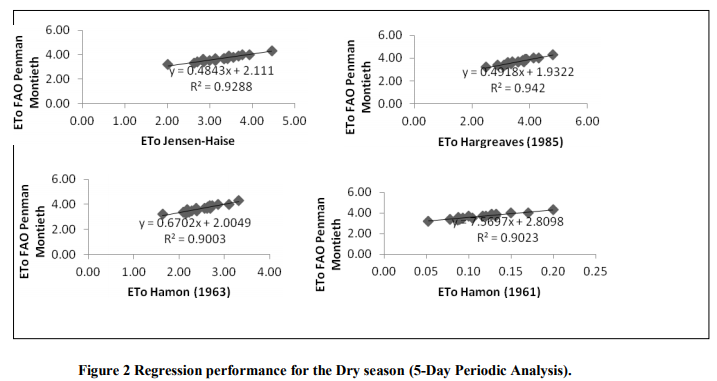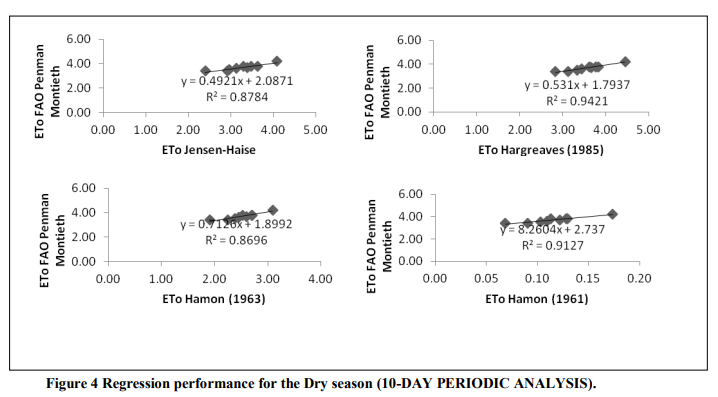IJCRR - 4(19), October, 2012
Pages: 209-216
Date of Publication: 15-Oct-2012
Print Article
Download XML Download PDF
THE FAO PENMAN MONTIETH METHOD OF ESTIMATING EVAPOTRANSPIRATION COMPARED WITH NINE OTHER METHODS IN CAPE COAST MUNICIPALITY, GHANA
Author: Joshua D. Owusu-Sekyere, Samuel A. Manu
Category: Technology
Abstract:A comparison of nine methods of evapotranspiration (ETO) determination with the FAO Penman-Montieth method was conducted. The nine methods are: Original Blaney-Criddle, Soil Conservation Service modified Blaney-Criddle, FAO Blaney-Criddle, Jensen-Haise, Hargreaves 1985, Hargreaves-Samani, Hamon 1963, Hamon 1961 and Piche evaporimeter. The investigations were conducted for both 5-day and 10-day periods for a duration of six months spanning May to July 2009 (three months of wet season) and November 2009 to January 2010 (three months of dry season). ETo estimates obtained were compared with ETo estimates from FAO Penman-Montieth method using correlation coefficient. The following methods; Jensen Haise, Hargreaves and Hamon (both 1961 and 1963) had consistently high correlation coefficients for the period and could thus be used to estimate evapotranspiration in the Cape Coast Municipality. A regression analysis was carried out for the methods which had consistently high correlation coefficients and the Penman-Montieth equation was done; thus the equations to use for predicting evapotranspiration values for the Penman-Montieth equation was achieved.
Full Text:
INTRODUCTION
Irrigation is essential to provide the moisture requirement of crops in arid parts of the world. In the Cape Coast Municipality where the annual rainfall is unable to supply the moisture requirement of crops, irrigation is essential. The practice of irrigation requires that one have the ability to determine the rate at which the crop uses water in order to determine how much to apply. Crop water use is determined by first estimating the evapotranspiration (ETo) of the crop. There are a number of methods available for use in estimating ETo of the crop. Some of them are direct methods whilst others are indirect. In 1990, FAO in collaboration with the International Commission for Irrigation and Drainage and the World Meteorological Organization, recommended the FAO Penman-Monteith method as a standard method for the definition and computation of ETo (Castañeda and Rao, 2005). This method is however data intensive and may thus never be adopted in areas where instrumentation is unavailable or processing power is low. It then becomes necessary to seek for simpler methods which require less data but are able to accurately estimate ETo. In view of this need, a number of the common methods of ETO estimation are compared with the Penman-Monteth method to ascertain which of these is best able to predict ETO values as accurately as possible.
MATERIALS AND METHODS
Study area: Cape Coast is the capital of the Central Region of Ghana, the town is coastal and has undulating plains with isolated hills and occasional cliffs characterized by sandy beaches and marsh. The land rises between 250 metres and 300 metres above sea level as one moves inland. The vegetation in Cape Coast is coastal savannah with grassland and a few trees, much of the original forest vegetation has been cleared for food crop cultivation, housing and urban development. The region lies within the dry equatorial zone and moist semi-equatorial zone. Annual rainfall averages around 1,000mm along the coast. The wettest months are May to June and September to October but December to February and a few weeks in August are dry. Mean monthly temperatures ranges from 240C in the coolest month (August) to approximately 300C in the hottest months (March to April).
MATERIALS
The following materials were used:
- Maximum glass thermometer
- Minimum glass thermometer
- Cup counter anemometer
- Sunshine recorder
- Piche evaporimeter
Nine methods of ETo estimation were used, one of them a direct method and the others indirect which employ empirical equations. The methods are listed below, the indirect ones are:
1. The original Blaney-Criddle formula (Blaney and Criddle, 1950)
2. FAO Blaney-Criddle method (Doorenbus and Pruitt 1977)
3. The SCS modified Blaney-Criddle formula (Hansen et al., 1979)
4. Jensen-Haise method (Jensen and Haise, 1963).
5. Hargreaves 1985 Reference Evapotranspiration equation (Hargraeves and Samani 1985).
6. Hargreaves-Samani equation (Hargreaves and Samani, 1985)
7. Hamon 1963 equation (Hamon, 1963)
8. Hamon 1961 equation (Hamon, 1961)
9. FAO Penman-Montieth method (Allen et al., 1998)
10. The Piche evaporimeter – direct method
Meteorological data
Metrological data covering a period of six months (May to July 2009 and November 2009 to January 2010) was obtained from University of Cape Coast meteorological station.
RESULTS AND DISCUSSIONS
Correlation values in addition to results obtained from regression analysis are presented and discussed.

Table 1 shows the correlation co-efficient between FAO Penman-Montieth and the tested methods. It also shows the performances of the tested methods. The Pearson’s correlation method for statistical testing was used to compute the coefficient of the tested methods. The 0.732 correlation coefficient obtained by the HargreavesSamani method shows that it is significant in ETo estimation for a 5-day period in the wet season but it shows a weak correlation coefficient when compared to the coefficient values obtained for the various direct and indirect methods used in the 5- day period ETo estimation for the wet season. The Hargreaves (1985) method showed the highest correlation coefficient of 0.999 which implies that the method performed better than all the methods used followed by Hamon (1963), Jensen-Haise, Hamon (1961), SCS modified Blaney-Criddle, FAO Blaney-Criddle, Original Blaney-Criddle, Piche evaporimeter and Hargreaves-Samani methods in descending order of correlation coefficient values. The original Blaney-Criddle method and the FAO Blaney-Criddle method can be preferred to each other during ETo estimation for a 5-day period in the wet season because both scored the same correlation coefficient value of 0.810 to the standard method (FAO-PM). Moreover, the table shows the correlation coefficient between FAO Penman-Montieth and the tested methods for the dry season. The Hargreaves (1985) equation showed the highest correlation coefficient of 0.971 for a 5-day period estimation of ETo in the dry season followed by the JensenHaise, Hamon (1961), Hamon (1963), Piche evaporimeter, Hargreaves-Samani, FAO BlaneyCriddle, original Blaney-Criddle, and SCS modified Blaney-Criddle methods in descending order of significance in estimating ETo for a 5-day period in dry season. Table 1 also shows the correlation co-efficients between FAO Penman-Montieth and the tested methods as well as the performance of the tested methods. The Hargreaves (1985), Hamon (1963) and Jensen-Haise methods showed a perfect correlation coefficient of 1.00 in the 10-day ETo estimation analysis in the wet season followed by the Hamon (1961),Hargreaves-Samani, SCS modified Blaney-Criddle, original Blaney-Criddle, FAO Blaney-Criddle and Piche evaporimeter methods in descending order of correlation coefficient values. The Hamon (1963) and the Jensen-Haise showing a perfect correlation in the 10-day period ETo estimation analysis in the wet season other than the 5-day period implies that the two methods are excellent when used in 10-day ETo estimation analysis in the wet season than a 5-day period analysis in the wet season. In descending order of significance the methods which ranked best in estimating ETo for a 10-day period in the wet season are the Hargreaves (1985), Jensen-Haise and Hamon (1963) methods followed by the Hamon 1961, Hargreaves-Samani, SCS modified Blaney-Criddle, original Blaney-Criddle, FAO Blaney-Criddle, and Piche evaporimeter methods in descending order of correlation significance to the FAO Penman Montieth method. However, the original Blaney-Criddle and the FAO BlaneyCriddle can be preferred to each other because they have the same correlation coefficient when estimating ETo for a 10-day period in the wet season. The correlation co-efficient between FAO Penman-Montieth and the tested methods. The Hargreaves (1985) was the highest correlated method with the FAO Penman-Montieth method followed by Hamon (1961), Jensen-Haise, Hamon (1963), Piche evaporimeter; Hargreaves-Samani, original Blaney-Criddle, FAO Blaney-Criddle and SCS modified Blaney-Criddle methods. The original Blaney-Criddle and the SCS BlaneyCriddle can be preferred to each in the estimation of ETo for a 10-day period in the dry season because they have the same correlation coefficient value when compared to the standard FAO56-PM. Since Pearson square correlation only gives an indication of the rises and falls in the patterns of the two compared methods and does not tell how closely or accurately the tested method quantifies ETo as the yardstick method it would be prudent to conduct a statistical test which does. A critical and empirical confirmation test was carried out by performing regression analysis to examine how closely or accurately the tested methods quantifies ETo as the yardstick method and also determine the relationships between the 5-day and 10-day period ETo estimates from the nine empirical methods and ETo values calculated by FAO-PM method. The regression equation is given by Y = mX + c, where, Y = ETo computed by FAO-PM method and X is the ET estimated from each of the other nine methods, and m and c are constant representing the slope and intercept of the regression equation respectively. The end regression equations together with the coefficient of determination (R2 ) are presented in Figure 1a to 4b for both wet and dry season analysis. The decision rules for the characteristic features of the best method include a "c” value closest to zero, an “m” value close to 1.0 and a high value of R2 .


Based on the decision rule, the results produced by the regression analysis in Figures 1a to 2b are evident that the performance details of the Hargreaves 1985 method is superior to the other eight methods for both the wet and the dry seasons in the 5-day periodic analysis. The Hargreaves 1985 matched very closely to the FAO-PM with a slope (m) of 0.505, an intercept (c) of 2.020 and a coefficient R2 of 0.997 for the 5-day periodic analysis in the wet season and a slope (m) of 0.491, an intercept (c) of 1.932 and a coefficient R 2 of 0.942 for the 5-day periodic analysis in the dry season. The Jensen-Haise method performed fairly good but better than the Hamon 1961 and 1963 methods for the 5-day periodic ETo regression analysis in both wet and the dry season.


Figures 3a to 4b, regression analysis from the results of the 10-day periodic intervals for both wet and dry seasons reveals that the Hargreaves 1985 method again gained superiority over the other eight (8) methods used for the comparison. The Hargreaves 1985 method produced the best dataset with a slope (m) of 0.523, an intercept (c) of 1.963 and a coefficient of R2 of 0.995 for the wet season and a slope (m) of 0.531, an intercept (c) of 1.793 and a coefficient of R2 of 0.942 for the dry season. The Jensen-Haise and Hamon 1963 methods generally gave the best next alternative desirable dataset for the slope “m”, intercept “c” and coefficient of R2 to the Hargreaves 1985 method. The Hamon 1961 method generally gave good dataset for coefficient of R2 and an intercept “c” but gave poor values for the slope (m) with respect to the decision rules. Comparing the regression performance analysis and correlation coefficient values for the 5-day and 10-day periodic analysis over the six months period, it is evident that conversely dataset obtained for the correlation coefficients, slope (m), intercept (c) and coefficient of determination (R2 ) by the Hargreaves-Samani, Original BlaneyCriddle, SCS Blaney-Criddle, Piche evaporimeter and FAO Blaney-Criddle methods unequivocally shows that the methods performed poorly with their original parameters after the regression analysis for both the wet and dry seasons. Generally the poor performance by the eight methods when compared to the Hargreaves 1985 method for the 5-day and 10-day regression performance analysis does not imply that they are bad methods for use but one can improve the end solutions, by recalibrating the values of their original constants parameters, for Cape Coast Municipality.
CONCLUSIONS
Based on critical and empirical analysis from the Pearson square correlation and regression analysis above, the Hargreaves 1985 method proves beyond reasonable doubt to be the best method for use with it original parameters in Cape Coast Municipality for ETo determination. It is also evident from the results produced by the radiation methods used in this investigation that radiation is an indispensable parameter in ETo determination and it greatly influence ETo result. It is therefore recommended that the Hargreaves (1985) method is the accurate, less costly, applicable, easy, simple and a practical method for successfully estimating ETo specifically in Cape Coast Municipality for both the wet and dry seasons.
References:
1. Allen, Richard G.; Pereira, Luis S.; Raes, Dirk; Smith, Martin;. (1998). Crop evapotranspiration - Guidelines for computing crop water requirements - FAO Irrigation and drainage paper 56. Rome, Italy, United Nations.
2. Blaney, H.F., and W.D. Criddle (1950). Determining Water Requirements in Irrigated Area from Climatological Irrigation Data, US Department of Agriculture, Soil Conservation Service.
3. Castaneda, L., & Rao, P. (2005). Comparison of methods for estimating reference evapotranspiration in Southern California. Journal of Environmental Hydrology , Vol.13, 1-10.
4. Doorenbos, J., and W.O. Pruitt.1977. Guidelines for predicting crop water requirements,” Irrigation and Drainage Paper 24, Food and Agriculture Organization of the United Nations, Rome, Italy.179 pp.
5. Hamon, W.R., ( 1961). “Estimating potential evapotranspiration”.Proc. Am. Soc. Civ. Eng. J. Hydraulic. Div. 87:107–120
6. Hansen, V.E., O.W. Israelsen and G.E. Stringham, 1979.Irrigation principles and practices. John Wiley and Sons, New York.
7. Hargreaves, G.H. and Z.A. Samani, 1985.Reference crop evapotranspiration from temperature. Transaction of ASAE 1(2):96-99.
8. Jensen, M.E and Haise, H.R., 1963. Estimating evapotranspiration from solar radiation. J. Irrig. Drainage Div. ASCE, 89:15- 41
9. Priestley, C.H. B., and R. J. Taylor (1972), On the assessment of surface heat flux and evaporation using large- scale parameters, Mon. Weather Rev., 100,81-92.
10. Wilson, E.M (1974), “Engineering hydrology” 2ndedition, pp. 35-53, The Macmillan Press Ltd, Hong Kong.
|






 This work is licensed under a Creative Commons Attribution-NonCommercial 4.0 International License
This work is licensed under a Creative Commons Attribution-NonCommercial 4.0 International License